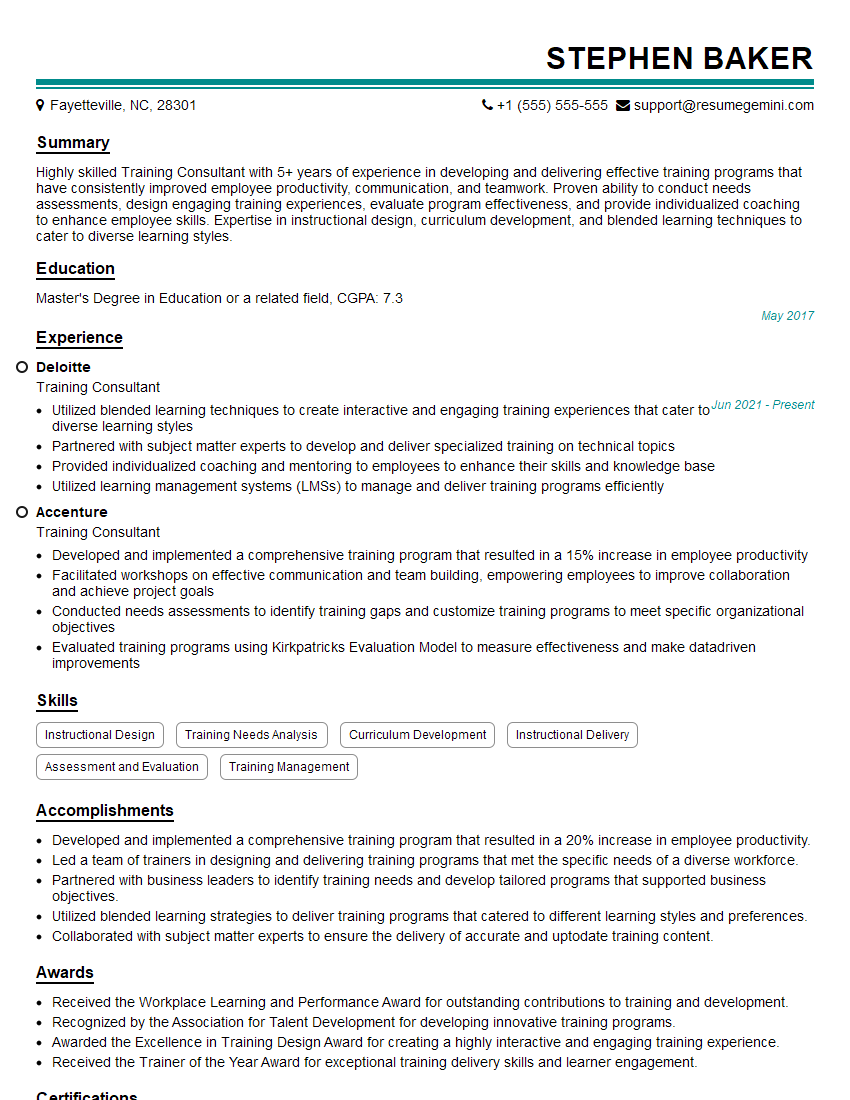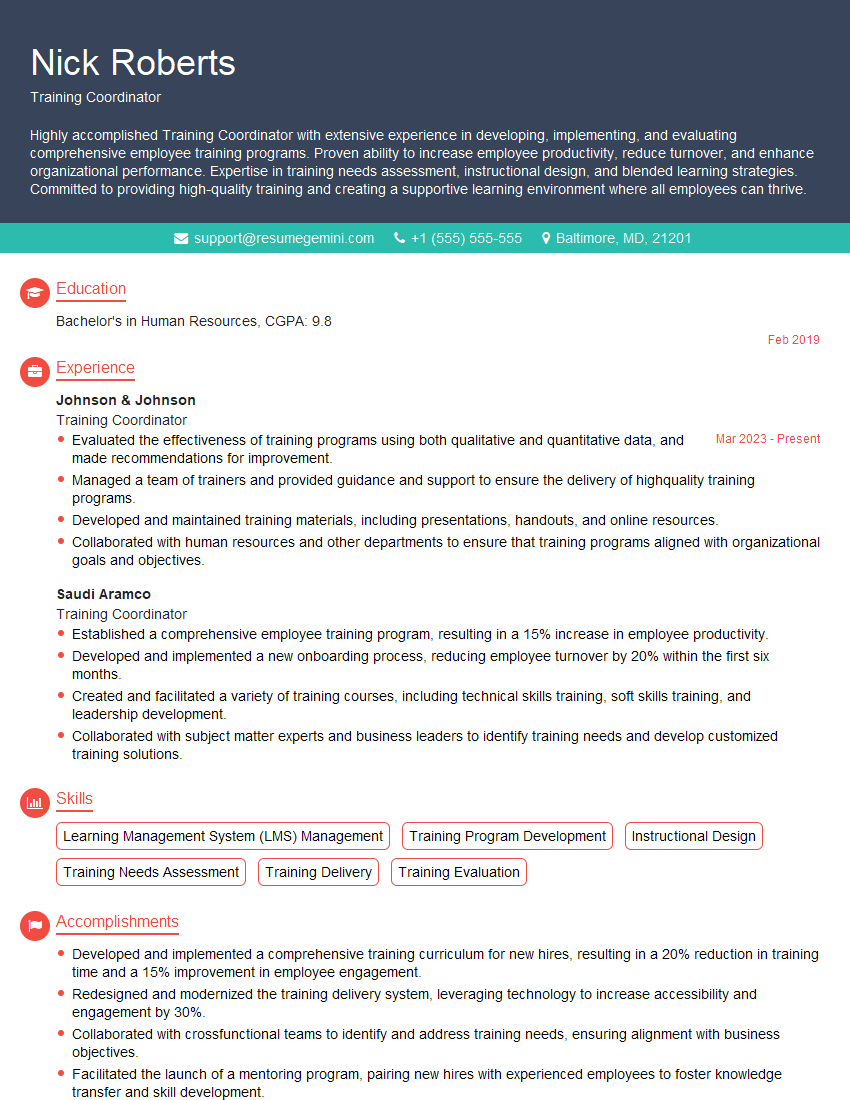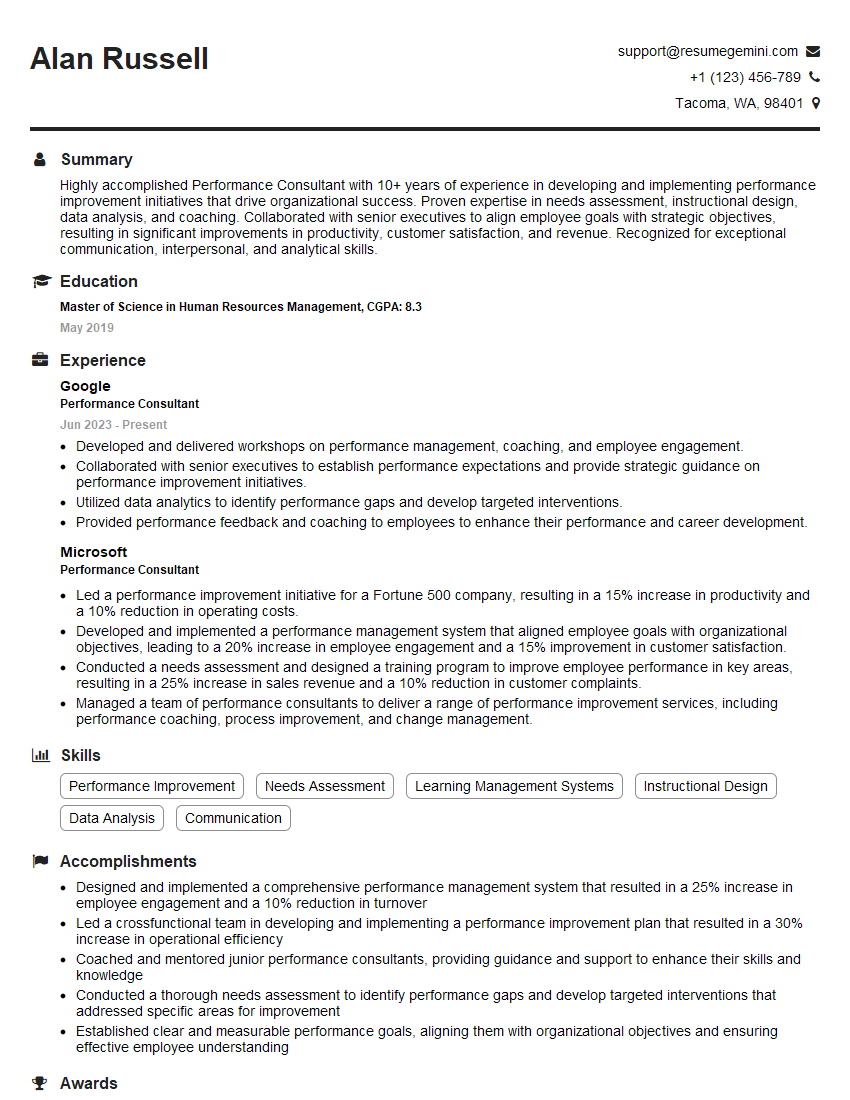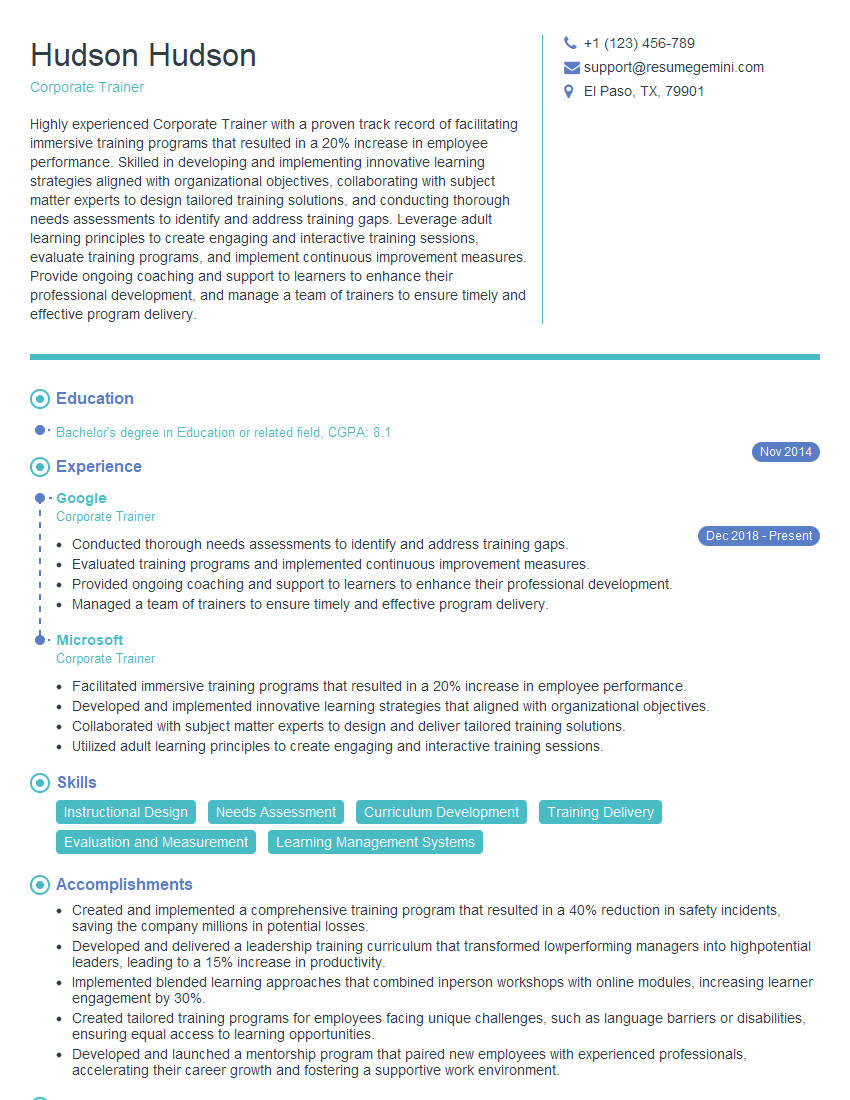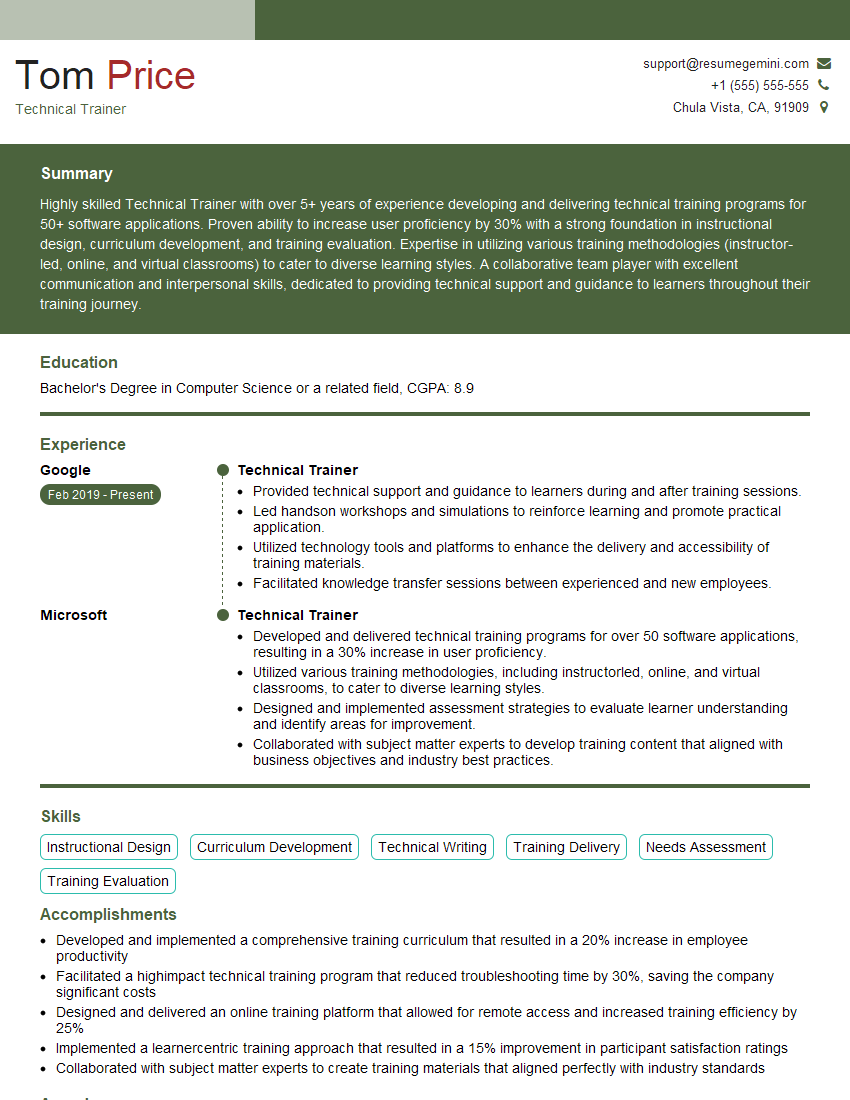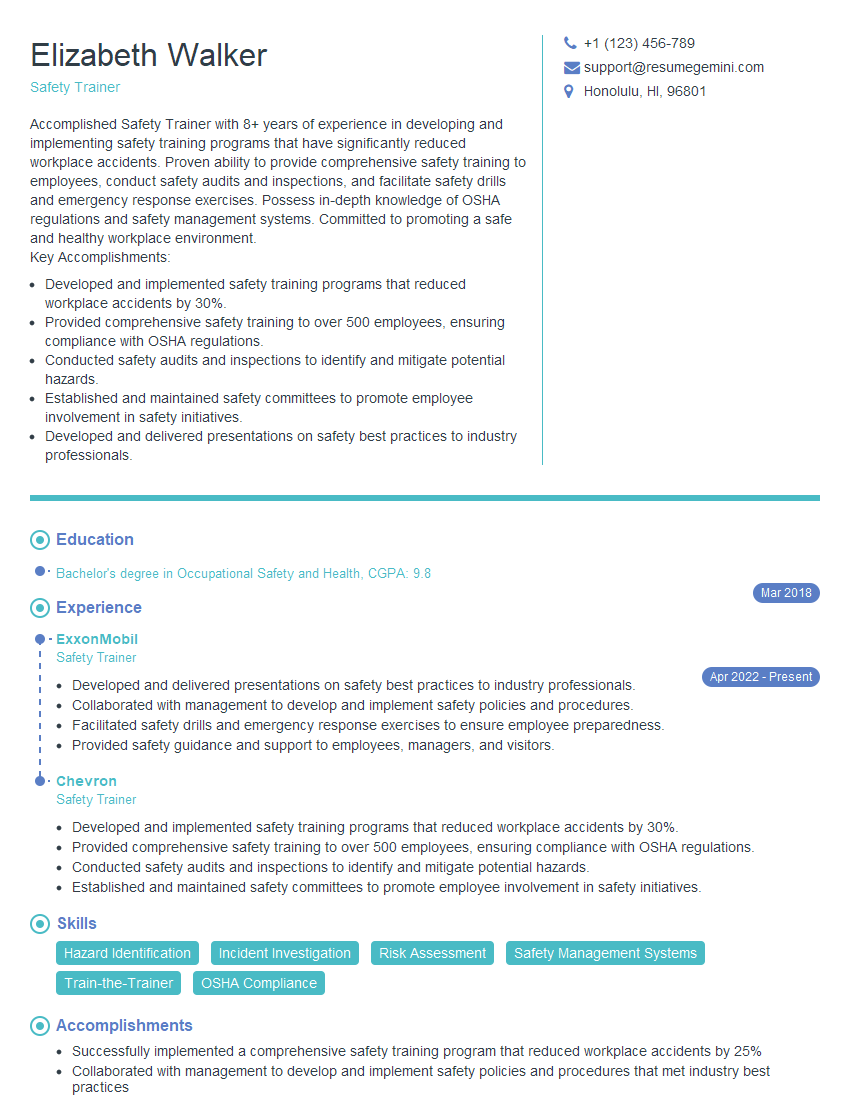Every successful interview starts with knowing what to expect. In this blog, we’ll take you through the top Familiarization Training Course interview questions, breaking them down with expert tips to help you deliver impactful answers. Step into your next interview fully prepared and ready to succeed.
Questions Asked in Familiarization Training Course Interview
Q 1. Define familiarization training and its key objectives.
Familiarization training introduces individuals to a new environment, system, or process. Its key objectives are to ensure participants understand the basics, build confidence, and prepare them for subsequent training or on-the-job performance. Think of it like getting a tour of a new city before you move there – you get a general sense of layout, key landmarks, and important routes. The training aims to reduce anxiety, improve safety, and promote efficiency. Key objectives include:
- Understanding Key Concepts: Participants gain a foundational grasp of essential information.
- Developing Basic Skills: Participants acquire the rudimentary skills needed for initial interaction.
- Increasing Confidence: Participants feel more comfortable and less apprehensive when faced with the new environment or system.
- Improving Safety: Familiarization with safety procedures helps prevent accidents.
- Boosting Efficiency: A basic understanding of workflows can lead to more effective performance.
Q 2. Explain the ADDIE model in the context of familiarization training.
The ADDIE model (Analysis, Design, Development, Implementation, Evaluation) is a widely used instructional design framework, perfectly applicable to familiarization training. Let’s break it down:
- Analysis: This stage involves identifying the training needs, target audience, and learning objectives. For example, if we’re training new employees on a new software system, we’d analyze their current technical skills, the software’s key features, and identify specific tasks they need to perform.
- Design: Here, we develop the training’s overall structure, content, and delivery methods. We’d choose appropriate learning activities, like interactive tutorials, videos, or simulations, to match the identified learning objectives. A storyboard would outline the training flow and content.
- Development: This is where the actual training materials are created – presentations, manuals, eLearning modules, etc. For our software training, we might develop interactive tutorials demonstrating key functions and short videos showcasing common workflows.
- Implementation: This involves delivering the training to the participants. This could be through in-person sessions, online courses, or a blended approach.
- Evaluation: This is crucial for assessing the training’s effectiveness. We’d use methods like quizzes, post-training surveys, and observation of on-the-job performance to measure learning and identify areas for improvement. We might track how quickly new employees become proficient with the software after the training.
Q 3. Describe different familiarization training delivery methods (e.g., online, in-person, blended).
Familiarization training can be delivered in various ways, each with its own strengths and weaknesses:
- Online: E-learning modules, videos, and online simulations offer accessibility and cost-effectiveness. This is particularly useful for geographically dispersed teams. Example: an interactive online tour of a company’s new facility.
- In-person: Classroom-based training, workshops, and demonstrations allow for direct interaction and immediate feedback. This is ideal for hands-on activities or when immediate clarification is needed. Example: a guided tour of a manufacturing plant, with opportunities for Q&A.
- Blended Learning: This combines online and in-person methods, leveraging the strengths of each. For instance, participants might complete an online module before attending a hands-on workshop. Example: Online modules introducing safety protocols followed by an in-person demonstration and practice session.
Q 4. How do you assess the effectiveness of a familiarization training program?
Assessing familiarization training effectiveness requires a multi-faceted approach. We need to measure both the learner’s understanding and their ability to apply the knowledge. Methods include:
- Pre- and Post-Training Assessments: These quizzes or tests gauge the increase in knowledge and comprehension. A pre-test identifies existing knowledge, while a post-test evaluates learning outcomes.
- Surveys and Feedback Forms: Gathering participant feedback on the clarity, usefulness, and engagement of the training is essential.
- Observations: Observing participants performing tasks related to the training helps assess practical application of knowledge. For example, we might observe new employees using the new software in their daily tasks.
- On-the-Job Performance: Monitoring performance metrics after the training provides a long-term evaluation of effectiveness. For instance, measuring error rates or task completion times post-training.
Q 5. What are some common challenges in designing and implementing familiarization training?
Designing and implementing familiarization training presents several challenges:
- Keeping it Concise: Familiarization training should be focused and avoid overwhelming participants with too much information. Finding the right balance between sufficient detail and brevity is crucial.
- Maintaining Engagement: Participants may find introductory training less engaging than more advanced material. Using varied methods and interactive elements can help combat this.
- Balancing Theory and Practice: Effective training needs a mix of theoretical knowledge and practical application. Striking the right balance is critical for achieving learning objectives.
- Managing Diverse Learning Styles: Participants have different learning preferences (visual, auditory, kinesthetic). Tailoring the training to accommodate diverse styles is essential for inclusive learning.
- Measuring Effectiveness: Demonstrating the return on investment (ROI) of familiarization training can be difficult. Clear learning objectives and robust evaluation methods are key.
Q 6. How do you tailor familiarization training to different learning styles?
Catering to different learning styles is crucial for maximizing the effectiveness of familiarization training. Here’s how:
- Visual Learners: Use diagrams, charts, videos, and presentations with strong visuals. Avoid lengthy text-heavy materials.
- Auditory Learners: Incorporate audio elements, discussions, lectures, and podcasts into the training. Group activities and verbal explanations can be very effective.
- Kinesthetic Learners: Include hands-on activities, simulations, role-playing, and practical exercises. Allow them to actively participate and manipulate materials.
- Reading/Writing Learners: Provide detailed manuals, handouts, and summaries. Encourage note-taking and self-paced learning.
A well-designed program integrates these methods, offering a multi-sensory experience to cater to all learning styles.
Q 7. Explain your experience developing training materials (e.g., presentations, manuals, eLearning modules).
Throughout my career, I’ve developed a wide range of training materials for various familiarization programs. For example, I once created an eLearning module for a new hospital information system. This involved:
- Needs Analysis: I interviewed hospital staff to identify their needs and the system’s key functionalities.
- Storyboarding: I created a detailed storyboard outlining the module’s structure, content, and interactive elements.
- Content Development: I developed engaging screen designs, interactive quizzes, and short video tutorials.
- Testing and Refinement: I conducted thorough testing with a pilot group to identify areas for improvement before full rollout.
I also have experience creating in-person training materials, including presentations, handouts, and participant workbooks. My approach always focuses on clear, concise content, complemented by engaging visuals and interactive activities to promote understanding and retention. I strive to create materials that are accessible to learners with diverse backgrounds and learning styles.
Q 8. Describe your experience delivering training to diverse audiences.
My experience delivering familiarization training spans diverse industries and audiences, from entry-level employees to seasoned professionals. I’ve worked with groups ranging in size from small workshops (5-10 participants) to large-scale corporate training sessions (50+). I tailor my approach based on the audience’s background, learning styles, and cultural differences. For example, when training a group of technicians, I focus on practical demonstrations and hands-on activities, while a training session for executives might emphasize strategic implications and high-level concepts. I always incorporate interactive elements to keep everyone engaged, regardless of the audience. This might include group discussions, quizzes, case studies or role-playing scenarios, adapted to the specific learning objectives and the audience’s comfort level.
To cater to diverse learning styles, I utilize a blended learning approach, combining presentations with interactive exercises, visual aids, and real-world examples. I also consider accessibility needs, ensuring materials are available in different formats (e.g., large print, audio versions) if required. I believe in creating a safe and inclusive environment where everyone feels comfortable participating, regardless of their background or experience level. Feedback mechanisms are implemented to gauge understanding and adapt accordingly.
Q 9. How do you handle difficult or disruptive participants during training sessions?
Handling disruptive participants requires a calm, professional approach. My first step is to understand the root cause of the disruption. Is the participant confused? Bored? Frustrated? I address the issue directly but respectfully, privately if possible. For example, if a participant is constantly interrupting, I might privately address their concerns, perhaps addressing a misunderstanding, or explaining the importance of letting others share their thoughts. If the disruptive behavior is due to boredom, I might adjust the pace or add more interactive elements. Sometimes, a simple re-engagement strategy – for example, posing a question directly to the participant – is all it takes to get them back on track.
If the disruption continues despite my attempts to address it privately, I might address it publicly, but always with respect and empathy. For example, I might say, ‘I understand you have a point, but to ensure we stay on schedule, can we address this question after the session?’ In extreme cases, I might need to ask the participant to step out, making sure to address the issue and create a plan for successful future participation. The key is to de-escalate the situation, maintain control, and ensure that the learning experience is not significantly impacted for the other participants.
Q 10. How do you incorporate technology into familiarization training?
Technology plays a crucial role in modern familiarization training. I incorporate technology in several ways. Firstly, I use interactive presentations with multimedia elements such as videos, animations, and simulations to make the training more engaging and memorable. Secondly, I utilize online learning platforms (LMS) like Moodle or Canvas to deliver pre-training materials, quizzes, and assessments. These platforms also allow for easy tracking of participant progress and performance. Thirdly, I integrate virtual reality (VR) or augmented reality (AR) technologies where appropriate to create immersive learning experiences, particularly for complex equipment or processes. For example, trainees could virtually explore a new factory layout or interact with a 3D model of a piece of machinery before working with the real thing. Finally, I leverage collaborative tools like online whiteboards or shared documents to facilitate teamwork and knowledge sharing during the training.
Using technology also allows me to gather data on participant learning and performance more efficiently. This data helps me to improve the training in the future, tailoring the content to better suit the learning needs of the participants.
Q 11. What are some best practices for creating engaging and effective training content?
Creating engaging and effective training content involves several best practices. First, I focus on the learning objectives. What specific knowledge or skills should participants gain? The content should directly address these objectives. Next, I use various learning modalities, such as storytelling, visual aids, real-world examples, and simulations, to cater to different learning styles. Active learning strategies, such as group discussions, quizzes, and hands-on activities, are critical for knowledge retention.
I also ensure that the content is relevant, timely, and easily accessible. I break down complex information into smaller, manageable chunks, using clear and concise language. Regular feedback and assessment throughout the training process are vital to gauge understanding and make adjustments as needed. Finally, I design training that is enjoyable and memorable, using humour (where appropriate) and incorporating relatable scenarios to maintain participant engagement. Post-training reinforcement, such as online resources or follow-up discussions, are also essential to support long-term knowledge retention.
Q 12. How do you ensure that familiarization training meets regulatory compliance requirements?
Ensuring familiarization training meets regulatory compliance requirements is paramount. This involves a thorough understanding of the relevant regulations for the specific industry and context. For example, in healthcare, this would involve HIPAA compliance, while in manufacturing, it may involve OSHA standards. I incorporate these requirements into the training materials, ensuring that all procedures and guidelines are clearly explained and documented. Training materials are reviewed and updated regularly to reflect any changes in legislation or best practices.
Documentation is crucial, and I maintain detailed records of all training activities, including participant attendance, assessments, and completion certificates. These records demonstrate compliance during audits. I actively seek out updates and guidance from regulatory bodies to ensure the training remains compliant. Moreover, training evaluations frequently assess the effectiveness of training materials and identify any areas needing improvement or adjustment to maintain compliance standards.
Q 13. Explain your experience with learning management systems (LMS).
I have extensive experience with various Learning Management Systems (LMS), including Moodle, Canvas, and TalentLMS. My experience encompasses course design and development within these systems, uploading training materials, managing user accounts, tracking participant progress, and generating reports on training completion and performance. I can leverage the features of an LMS to create interactive courses, assign quizzes and assessments, track individual progress, and provide automated feedback. I am proficient in using the reporting functionalities of these systems to analyze training data and identify areas for improvement.
For instance, I use the LMS to schedule and deliver online modules, assign pre- and post-training assessments, and provide participants with access to supplementary learning materials. The data collected within the LMS allows me to identify areas where trainees might be struggling and tailor the training accordingly. This is vital for continuous improvement and optimization of the training program.
Q 14. How do you use data to inform the design and improvement of familiarization training programs?
Data is integral to the design and improvement of any training program. I use data from various sources, including LMS data (completion rates, quiz scores, assessment results), participant feedback surveys, and post-training performance evaluations to inform the design and refinement of our familiarization training. For example, low quiz scores on a specific topic might indicate a need to revise that section of the training, perhaps adding more interactive elements or simplifying the explanation. Similarly, feedback from participant surveys can highlight areas where the training is unclear, boring, or irrelevant.
By analyzing this data, I can identify trends, pinpoint areas for improvement, and ultimately create a more effective and engaging training experience. This data-driven approach allows for continuous improvement and ensures the training program remains relevant, up-to-date, and aligned with the specific needs of the target audience. This ensures we are not only meeting compliance but are also delivering highly effective training that results in improved performance.
Q 15. Describe a time you had to adapt a familiarization training program due to unexpected circumstances.
Adapting a familiarization training program requires flexibility and quick thinking. One instance involved a sudden system outage just days before a large-scale training session for new customer service representatives. Our initial plan relied heavily on a live demonstration of our CRM software. Instead of canceling, we quickly pivoted. We created a detailed walkthrough using screenshots and video tutorials focusing on the key functionalities, and we prepared supplementary materials explaining the outage and its temporary impact. We also scheduled additional, hands-on training sessions once the system was restored. The result? While slightly delayed, the training remained effective, and participants appreciated the proactive problem-solving.
Another example involved adapting to a change in company policy on data handling, mid-training. We immediately added a supplementary module to address the new regulations and incorporated these changes into the training materials and subsequent assessment. We sent out revised documentation, and communicated the change to all training staff to ensure consistency across all learners. This ensured compliance and maintained the training’s relevance.
Career Expert Tips:
- Ace those interviews! Prepare effectively by reviewing the Top 50 Most Common Interview Questions on ResumeGemini.
- Navigate your job search with confidence! Explore a wide range of Career Tips on ResumeGemini. Learn about common challenges and recommendations to overcome them.
- Craft the perfect resume! Master the Art of Resume Writing with ResumeGemini’s guide. Showcase your unique qualifications and achievements effectively.
- Don’t miss out on holiday savings! Build your dream resume with ResumeGemini’s ATS optimized templates.
Q 16. How do you measure the return on investment (ROI) of a familiarization training program?
Measuring the ROI of familiarization training isn’t about simply counting attendees. It involves a multi-faceted approach. We typically assess ROI through several key performance indicators (KPIs). These include:
- Reduced onboarding time: How much faster are new employees up to speed compared to previous cohorts? This is measured by time-to-productivity metrics.
- Improved employee performance: This is assessed through performance reviews, task completion rates, and customer satisfaction scores (particularly relevant for customer-facing roles).
- Lower error rates: Reduced mistakes and improved accuracy resulting from the training, measured through quantifiable metrics.
- Increased employee retention: A well-designed familiarization program fosters engagement, reducing turnover. We track this through employee attrition data.
- Employee satisfaction: Post-training surveys gauge participant satisfaction with the program’s effectiveness and content.
By quantifying improvements in these areas, we can create a robust cost-benefit analysis, demonstrating the tangible value of the training investment.
Q 17. What are some common misconceptions about familiarization training?
Several misconceptions surround familiarization training. A common one is that it’s only for new hires. Familiarization training is crucial for existing employees as well, particularly when there are system updates, policy changes, or new product launches. Another misconception is that it’s simply a dumping ground of information. Effective familiarization training is highly interactive, engaging, and focused on practical application, not just passive learning.
Another misconception is that it’s a one-size-fits-all approach. The content should be tailored to the specific needs and roles of the participants, not a generic overview of the organization. Finally, some believe it’s optional or less important than other types of training; in reality, effective familiarization is foundational to employee success and organizational efficiency.
Q 18. How do you build rapport and trust with participants in familiarization training?
Building rapport and trust is paramount. I start by creating a safe and inclusive environment where participants feel comfortable asking questions and sharing their experiences. This involves active listening, acknowledging individual concerns, and fostering open communication. I use icebreakers and team-building activities at the start of the training to facilitate interaction and build connections.
Transparency is key; I clearly communicate the training’s objectives, structure, and expectations from the outset. I also demonstrate my own expertise and passion for the subject matter. By being approachable, empathetic, and responsive to individual needs, I build trust and create a positive learning experience. Regular informal check-ins also help monitor learner progress and address any issues promptly. Creating a two-way feedback mechanism allows the participants to feel heard.
Q 19. What are the key elements of a successful onboarding program incorporating familiarization training?
A successful onboarding program incorporating familiarization training should be structured and well-planned. Key elements include:
- Pre-boarding activities: Sending welcome packages, assigning buddies, and providing pre-reading materials to help new hires prepare for their first day.
- Orientation: A comprehensive overview of the company’s culture, values, and history.
- Role-specific familiarization: Detailed training on the employee’s specific job functions, responsibilities, and required software/systems. This is the core of the familiarization process.
- Mentorship or buddy system: Pairing new hires with experienced colleagues for guidance and support.
- Regular check-ins and feedback sessions: Monitoring progress, providing support, and gathering feedback throughout the onboarding period.
- Clear expectations and goals: Defining milestones and performance indicators to track progress.
- Continuous learning opportunities: Providing access to further training and development resources.
The entire process should be designed to accelerate the new hire’s integration into the company and ensure they quickly become productive and engaged members of the team.
Q 20. Describe your experience with needs analysis for familiarization training.
Needs analysis is the cornerstone of any effective familiarization program. It’s a systematic process of identifying the knowledge, skills, and abilities (KSAs) that employees need to perform their jobs successfully. I typically use a multi-pronged approach.
This involves interviews with managers, subject matter experts, and existing employees. We also analyze job descriptions, performance reviews, and even observe employees performing their tasks to understand any existing gaps in training. Surveys and questionnaires help collect broader perspectives from employees about training needs and preferences. This data is then synthesized to develop a targeted and relevant training plan.
For example, if the needs analysis reveals a lack of proficiency in a specific software among customer service representatives, the familiarization training will focus intensely on that software. Without a thorough needs analysis, we risk creating irrelevant or ineffective training materials.
Q 21. How do you incorporate feedback from participants into the design of familiarization training?
Feedback is crucial for continuous improvement. I incorporate participant feedback through various methods:
- Post-training surveys: These provide quantitative and qualitative data on the effectiveness of the training materials, delivery, and overall learning experience.
- Focus groups: Small group discussions offer in-depth insights into participant perceptions and suggestions for improvement.
- Individual interviews: More personalized feedback allows for in-depth understanding of specific challenges and areas needing attention.
- Informal feedback sessions: Regular opportunities for participants to share their thoughts and suggestions throughout the training.
This data is then carefully analyzed to identify areas for improvement, such as revising content, adjusting the training methodology, or improving the overall learning experience. This iterative process ensures the training program remains relevant, effective, and aligned with the evolving needs of the organization and its employees.
Q 22. What are some strategies for maintaining learner engagement throughout a familiarization training program?
Maintaining learner engagement in familiarization training is crucial for effective knowledge transfer. Think of it like a captivating story – you need to keep your audience hooked from beginning to end. I employ several strategies:
- Interactive Activities: Instead of passive lectures, I incorporate quizzes, group discussions, hands-on exercises, and simulations. For instance, in a software familiarization course, I might have participants complete a mock project using the software.
- Gamification: Introducing game mechanics like points, leaderboards, or badges can significantly boost motivation and participation. A simple points system for completing modules or answering quizzes can make learning feel like a game.
- Real-World Applications: Connecting the training to learners’ everyday tasks makes the material relevant and impactful. Showing how the familiarization directly improves their job performance is key. For example, demonstrating how a new safety procedure reduces workplace hazards.
- Varied Learning Methods: I avoid monotony by blending different learning styles – visual aids, audio clips, demonstrations, and discussions. This caters to diverse learning preferences.
- Regular Feedback and Reinforcement: Providing regular feedback, both during and after the training, helps learners track their progress and stay motivated. This could be through quizzes, peer reviews, or individual check-ins.
- Storytelling and Real-Life Examples: Injecting relatable stories and case studies makes the learning more memorable and engaging. For example, sharing success stories of others who mastered the same software.
Q 23. Describe your experience with different assessment methods used in familiarization training.
My experience encompasses a range of assessment methods, tailored to the specific learning objectives of each familiarization program. I believe in a blended approach, combining formative and summative assessments for a holistic evaluation.
- Pre-Tests/Needs Assessments: To gauge prior knowledge and tailor the training accordingly.
- Knowledge Checks (Formative): Short quizzes embedded throughout the training to monitor understanding and identify knowledge gaps. These are usually low-stakes, allowing learners to learn from mistakes.
- Practical Exercises/Simulations (Formative & Summative): Hands-on activities to assess the application of learned skills in realistic scenarios. For example, a simulated emergency response drill for safety training.
- Observations (Formative): Observing learners during practical exercises to assess their competence and provide immediate feedback.
- Post-Tests/Summative Assessments: Comprehensive evaluations at the end of the program to measure overall knowledge retention and skill acquisition. This might include written exams, practical demonstrations, or case studies.
- Performance-Based Assessments: Evaluating learners’ performance on real-world tasks, such as operating specific machinery or using software to complete a project. This is particularly relevant for technical familiarization training.
Q 24. How do you stay current with best practices in familiarization training?
Staying current is paramount. I actively participate in professional development activities to remain at the forefront of familiarization training best practices.
- Professional Organizations: Membership in relevant professional organizations provides access to conferences, webinars, and journals showcasing cutting-edge methodologies and research. For example, organizations focused on training and development, or those specific to the industry I am training for.
- Industry Publications and Research: I regularly read industry publications and research papers to understand emerging trends and technological advancements. This ensures the content remains relevant and incorporates the latest best practices.
- Conferences and Workshops: Attending conferences and workshops allows me to network with other professionals, share best practices, and learn about new approaches to familiarization training.
- Online Courses and Webinars: I utilize online learning platforms to expand my knowledge in instructional design, adult learning theories, and relevant software tools.
Q 25. What software or tools are you proficient in using for familiarization training development?
I’m proficient in several software and tools crucial for developing and delivering effective familiarization training.
- Articulate 360: For creating interactive e-learning modules and simulations.
- Adobe Captivate: Another robust tool for developing engaging e-learning content.
- Camtasia: For creating screen recordings and video tutorials.
- Microsoft PowerPoint and Excel: For creating presentations and tracking training data.
- Learning Management Systems (LMS): Such as Moodle, Canvas, and Blackboard, for delivering and managing online training courses.
- Zoom/Teams/WebEx: For conducting virtual training sessions and providing remote support.
Q 26. Explain your understanding of adult learning principles and how you apply them to familiarization training.
Understanding adult learning principles is fundamental. Adults learn differently than children. They’re self-directed, experience-based, and goal-oriented. My approach aligns with these principles:
- Relevance and Applicability: I emphasize how the training relates to learners’ jobs and goals. I show them *why* they need to learn this material.
- Active Participation: I encourage active participation through discussions, activities, and hands-on exercises, avoiding passive lectures.
- Experiential Learning: I incorporate case studies, simulations, and real-world examples to make the learning more meaningful and memorable.
- Self-Paced Learning: When possible, I offer flexible learning options that allow learners to progress at their own pace. This is especially important in online familiarization training.
- Respect for Prior Experience: I acknowledge and build upon learners’ existing knowledge and experience. This shows them that their contributions are valued.
- Immediate Feedback: I provide timely and constructive feedback to help learners track their progress and identify areas for improvement.
Q 27. How do you manage the budget for a familiarization training program?
Budget management is crucial. I employ a systematic approach:
- Needs Assessment: A thorough needs assessment identifies the exact training requirements, preventing unnecessary expenses.
- Cost-Benefit Analysis: I weigh the costs of different training options (e.g., in-person vs. virtual) against the expected benefits, optimizing ROI.
- Resource Allocation: I carefully allocate resources, including instructor fees, materials, technology, and venue costs, to ensure efficient spending.
- Tracking and Reporting: I monitor spending throughout the program, and provide regular reports to stakeholders on budget adherence and progress.
- Negotiation and Procurement: I actively negotiate with vendors to secure the best possible prices for training materials and services.
- Explore Alternative Options: I explore cost-effective alternatives such as using free or open-source software and leveraging existing resources.
Q 28. Describe your experience with creating and delivering virtual familiarization training.
I have extensive experience in creating and delivering virtual familiarization training. It requires a different approach than in-person training, emphasizing engagement and accessibility:
- Interactive Online Content: I use interactive tools and techniques such as gamification, simulations, and virtual reality to keep learners engaged.
- Short, Focused Modules: Breaking down the training into shorter, more manageable modules helps maintain attention spans.
- Regular Check-ins and Q&A Sessions: I incorporate regular breaks and Q&A sessions to address questions and provide support.
- Collaboration Tools: I leverage collaboration tools like online forums, chat features, and breakout rooms to facilitate interaction among learners.
- Accessibility Considerations: I ensure accessibility for learners with disabilities by using captioning, transcripts, and alternative formats.
- Technical Support: I provide clear instructions and readily available technical support to address any technical difficulties.
- Engaging Visuals and Multimedia: I incorporate high-quality visuals, videos, and audio to enhance the learning experience.
Key Topics to Learn for Familiarization Training Course Interview
- Course Overview and Objectives: Understand the core goals and intended outcomes of the Familiarization Training Course. Be prepared to articulate how the training aligns with your career aspirations.
- Key Processes and Procedures: Demonstrate a thorough understanding of the practical applications learned during the course. Be ready to discuss specific processes and how you would handle real-world scenarios.
- Software and Tools Proficiency: Highlight your competency with any software or tools introduced in the course. Prepare examples showcasing your ability to effectively utilize these resources.
- Problem-Solving and Troubleshooting: Discuss your approach to identifying and resolving challenges encountered during the training. Emphasize your analytical skills and ability to learn from mistakes.
- Teamwork and Collaboration: If applicable, describe your experiences collaborating with others during the course. Highlight your contributions and your ability to work effectively within a team environment.
- Safety and Compliance Procedures: Demonstrate a strong understanding of any safety protocols or compliance requirements covered in the course. This shows a commitment to responsible and ethical practices.
- Data Analysis and Interpretation: If the course involved data analysis, be prepared to discuss your ability to interpret findings and draw meaningful conclusions.
Next Steps
Mastering the Familiarization Training Course significantly enhances your skillset and opens doors to exciting career opportunities. A strong understanding of these concepts will make you a highly competitive candidate. To maximize your job prospects, focus on creating an ATS-friendly resume that effectively highlights your newly acquired skills and experience. We strongly recommend using ResumeGemini, a trusted resource, to build a professional and impactful resume. Examples of resumes tailored specifically to the Familiarization Training Course are available to help guide you. Investing time in crafting a compelling resume is crucial for successfully navigating the job market.
Explore more articles
Users Rating of Our Blogs
Share Your Experience
We value your feedback! Please rate our content and share your thoughts (optional).
What Readers Say About Our Blog
Interesting Article, I liked the depth of knowledge you’ve shared.
Helpful, thanks for sharing.
Hi, I represent a social media marketing agency and liked your blog
Hi, I represent an SEO company that specialises in getting you AI citations and higher rankings on Google. I’d like to offer you a 100% free SEO audit for your website. Would you be interested?
